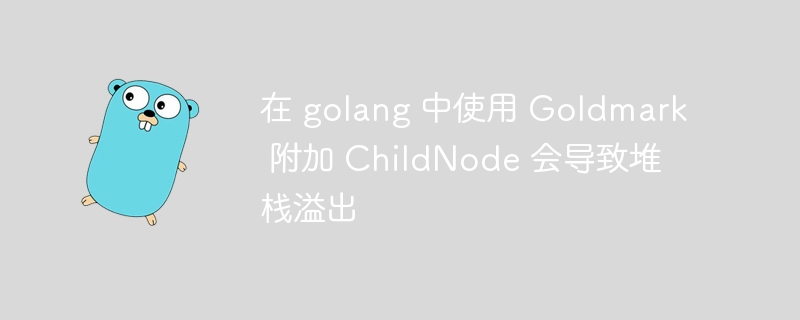

I've been using goldmark in go and I'm new to it so I'm not sure if I'm doing this correctly. I've been reading the documentation, but I'm a little confused as to why this is happening.
I have parsed a markdown file and used ast.walk to walk through the ast.
My goal is to inject a sublist under the list item.
ast.walk(doc, func(n ast.node, entering bool) (ast.walkstatus, error) {
if entering {
if n.kind() == ast.kindlistitem {
sublist := ast.newlist(0)
sublistitem := ast.newlistitem(0)
sublist.appendchild(sublist, sublistitem)
leaf := ast.newstring([]byte("hello"))
sublistitem.appendchild(sublistitem, leaf)
n.appendchild(n, sublist)
}
}
return ast.walkcontinue, nil
})
However, when I run this, I get
runtime: goroutine stack exceeds 1000000000-byte limit runtime: sp=0xc04f9803c8 stack=[0xc04f980000, 0xc06f980000] fatal error: stack overflow
I think this is caused by adding a new node and accessing that node on the next iteration. But I'm not entirely sure how to skip new nodes.
You are right, the stack overflow error is caused by the access of a new node.
To solve this problem, you can record the added nodes and skip them in the walk function.
// for recording the added nodes
added := make(map[*ast.List]bool)
ast.Walk(doc, func(n ast.Node, entering bool) (ast.WalkStatus, error) {
if entering {
if n.Kind() == ast.KindList {
if _, ok := added[n.(*ast.List)]; ok {
// skip the added node
return ast.WalkSkipChildren, nil
}
}
if n.Kind() == ast.KindListItem {
subList := ast.NewList(0)
subListItem := ast.NewListItem(0)
subList.AppendChild(subList, subListItem)
leaf := ast.NewString([]byte("Hello"))
subListItem.AppendChild(subListItem, leaf)
n.AppendChild(n, subList)
// record the added node
added[subList] = true
}
}
return ast.WalkContinue, nil
})
The above is the detailed content of Using Goldmark to attach ChildNode in golang causes stack overflow. For more information, please follow other related articles on the PHP Chinese website!
 How to solve Java stack overflow exception
How to solve Java stack overflow exception
 phpstudy database cannot start solution
phpstudy database cannot start solution
 The difference between flutter and uniapp
The difference between flutter and uniapp
 What does legacy startup mean?
What does legacy startup mean?
 Hide taskbar icon software
Hide taskbar icon software
 windows boot manager
windows boot manager
 Three major frameworks for android development
Three major frameworks for android development
 Introduction to commonly used top-level domain names
Introduction to commonly used top-level domain names




